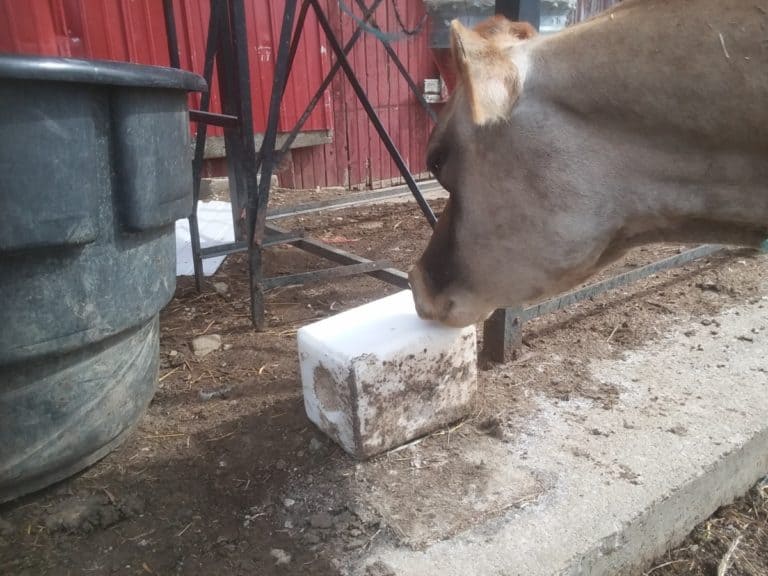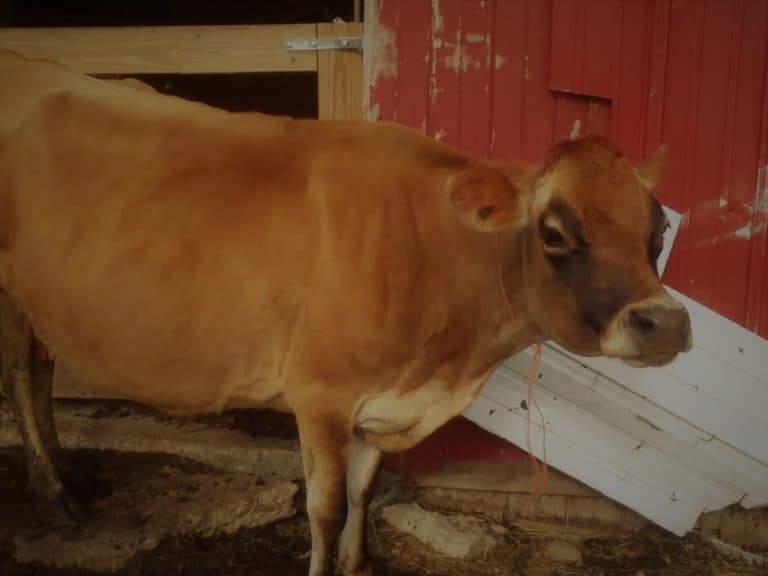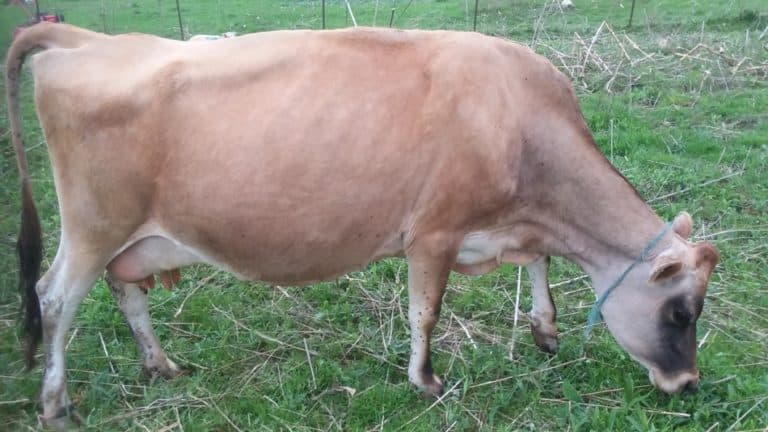A Family Cow: How Much Will She Milk?
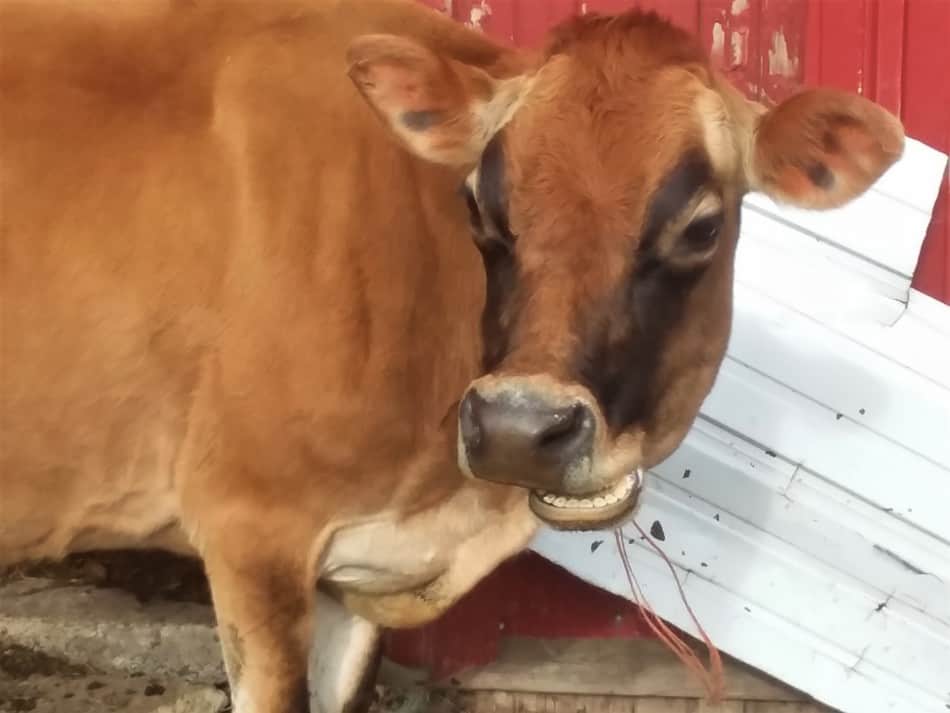
Thinking about getting a family cow? You’ll love the amazing taste of the milk and have plenty of fresh cream!
How much will you get a day and what can you do to manage her production?
Your cow will most likely milk between 2-3 gallons per day. This will vary with feeding, stage of lactation, age, health and breed of cow.
How do you know if you’re ready? My guide “Are You Ready For A Family Cow?” will walk you through the things you need to have figured out, including feeding needs and daily care, before you get your cow.
Congratulations, this is exciting stuff!
We have had a family cow for years, a Jersey named Aleene. She was part of our herd when we milked for a living. We love the plentiful milk and are big believers in drinking it real, you might say raw.
If you are more comfortable with pasteurizing your milk, go for it! Good news, it’s your milk so you can do as you please!
Daily Care For Family Cow shows you the things you need to have in your routine to keep your cow (and you) happy.
We’ll go over how much milk you can expect from your cow and what you can do management wise that will change the amount she produces.
Good management and husbandry of your cow will will help her live her genetic potential.
Poor management and/or husbandry will have her living and performing below her potential.
There are limits of production, mainly individual ability and stage of lactation, but all cows can be managed for higher or lower production.
5 Best Breeds For A Family Cow gives you the top breeds that are the most likely to make a great cow for your family.
| Cow | Amount of milk |
| Jersey, peak lactation | 3 gallons per day |
| Jersey, mid lactation | 2 gallons per day |
| Jersey, late lactation | 1.5 gallons per day |
Your cow will milk 2-3 gallons per day
Our cow produces 2-3 gallons per day, as an average.
You can count on at least a gallon a day, even in the late stages of lactation when she is at her lowest milk per day.
If you are considering a cow that has production records, this is easy. Milk production is measured in pounds and there are 8 pounds to a gallon.
Here’s an example: the production records state that the cow of your choice is producing 24 pounds of milk per day. Divide 24 by 8 to get 3 gallons of milk per day.
Remember, your cow will milk the amount that is biologically appropriate for her in the environment you provide for her.
Her daily environment includes how you treat her and what she eats.
How do you know if you’re ready? My guide “Are You Ready For A Family Cow?” will walk you through the things you need to have figured out, including feeding needs and daily care, before you get your cow.
You do not have to feed grain
No, your cow does not need grain! We don’t feed Aleene grain, ever. But, and this is a pretty big but, our cow does just fine without grain.
She keeps on weight, she seems happy and she has plenty of grass or hay to eat to get all the nutrition she needs.
If and/or when Aleene looks like she needs some grain, we will happily give it to her. Until then, she is doing well without it.
| Milk Cow Management Choice | Milk Production Result (vs her potential production) |
| No grain to cow | lower |
| High quality pasture | high |
| Low quality pasture | lower |
| Varying routine, especially milking time | lower |
| High stress, including weather | lower |
| Restricted water intake (including slippery/icy footing to get the water) | lower |
| Cow is fat | lower |
| Cow is thin | lower |
| Cow is well fed with slick hair coat | high |
Aleene (our Jersey) milks 2-3 gallons per day
For us, Aleene produces 2-3 gallons of milk per day.
She is not fed grain and is given the freedom to roam about the barnyard and close fields as she chooses.
She always has access to grass, but in the winter she needs hay as well.
The plus side of this hands off style is she just needs access to plenty of hay, actually it’s haylage, and water and she takes care of herself.
The down side of this system is she will poop where ever and we have to be vigilant about keeping the gate to the feed shut!
Why am I telling you this? What Aleene eats and how she feels, happy or stressed, low or high energy food, will all affect how much milk she produces at a specific point in her lactation.
The same will be true for your cow.
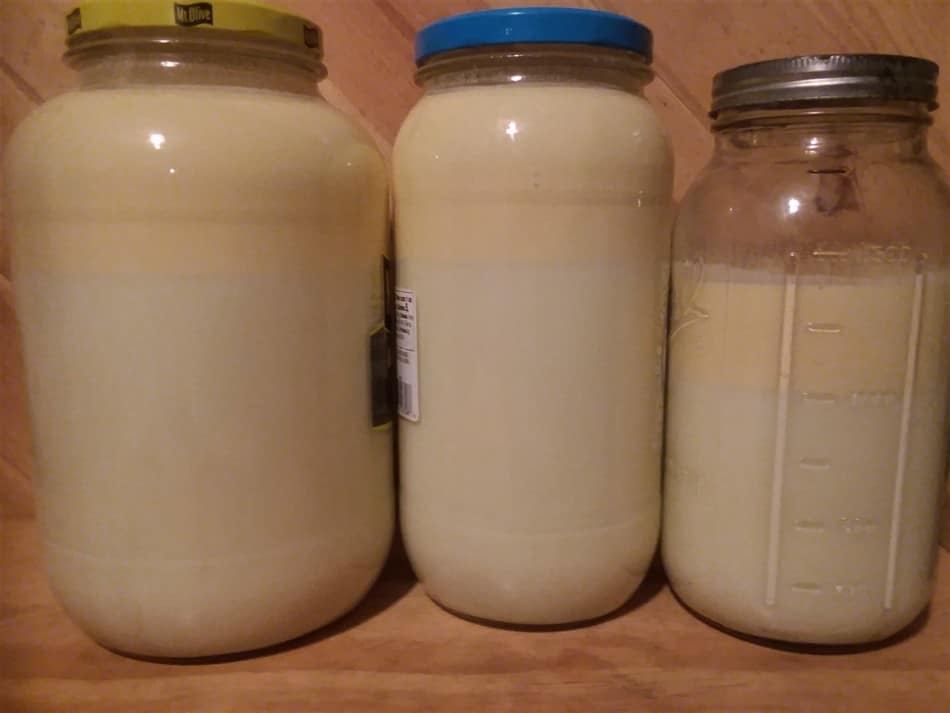
A few lactation basics, supply and demand
The milk a cow produces follows what is called a lactation curve.
The curve really looks more like a mountain: with a steep side to the top then a more gentle slope back to the bottom.
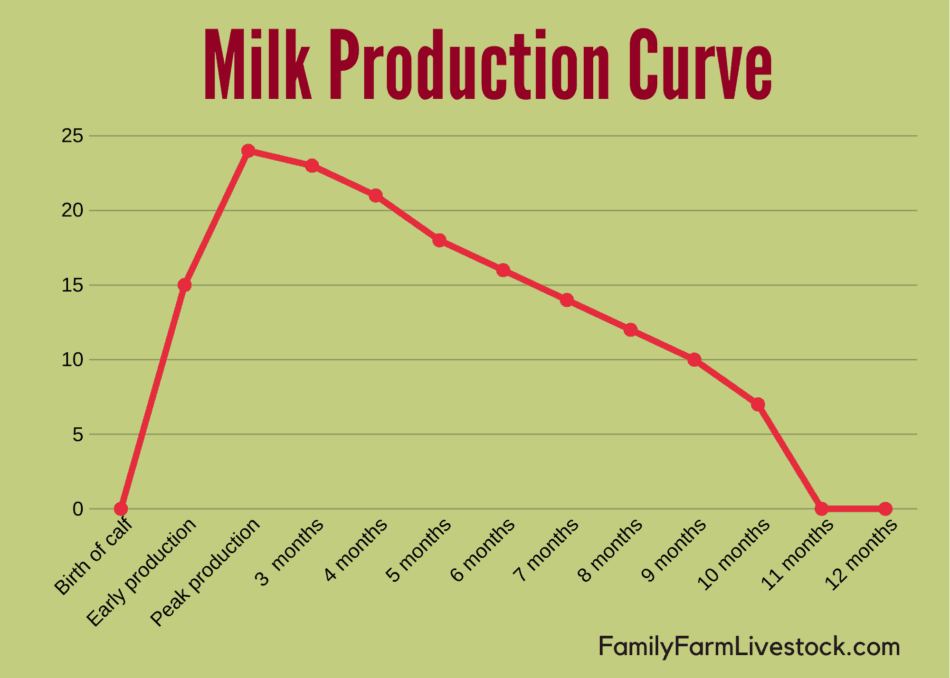
Milk production is based on supply and demand, you take the milk she makes more.
You leave the milk (skip milkings or vary times of milkings) she interprets that as you leaving the milk so she makes less.
For more info read my article How To Hand Milk A Cow for all the details on milking by hand.
Her milk production will peak at about 6 weeks after freshening (having a baby) then it will gradually taper off as the lactation period continues.
How long she stays at peak production and how fast she tapers off in production are based off of genetics and your management.
The ideal milk cow calving cycle is 12 months
Ideally, you will have her bred back at 3 months after freshening. This will put her on a one year production cycle.
Being a month or so later is not a big deal, but will move the birth of the calf and therefore the start of milking back.
Not a big deal unless you get multiple months off schedule are are counting on grass based milk.
If you need her to freshen at a specific time for your area, detecting heats and getting her bred back for the appropriate time is critical.
She will ideally be dry (you are no longer milking her) at 10 months, so she will have 2 month off of milking until she has another baby at about 12 months (close to the same date of last year’s calf).
If she’s not bred, keep milking her!
As I mentioned above, ideally your cow will stay on a 12 month schedule.
For a commercial dairy this is a pretty big deal, since maintaining this 12 month schedule is the best way to keep a cow healthy and profitable at the same time.
For you, probably not such a big deal.
Just be aware the longer it takes to get her bred back, the further away from more milk you will be if she dries up faster than you had planned on.
How do you know if you’re ready? My guide “Are You Ready For A Family Cow?” will walk you through the things you need to have figured out, including feeding needs and daily care, before you get your cow.
You can help your family cow produce more milk
- Keep her in great health
- Keep a milking schedule
- Feed her more high energy food
- Be sure she has easy access to water
- She needs a comfortable place to hang out
- Keep her udder soft
Keep your milk cow in great health
How can you tell f she is healthy, you ask? It’s actually pretty easy. She should have a slick, shiny hair coat.
In the winter the hair coat with be thicker and longer, but it still should look nice.
Another easy way to spot a healthy cow is that she is laying down chewing her cud. When a cow is full, she relaxes and chews her cud.
If you are not seeing much cud chewing then look into what might be missing.
She should be eating, drinking or chewing her cud any time you look at her. If not, do some investigating.
Keep to a milking schedule, cows love routine
You should milk your cow twice a day as close to 12 hours apart as you can. When you milk doesn’t matter, just pick a time and stick to it. Cows love routine!
If you need to change the milking time, make the change slowly over a few days.
Your cow can’t tell the difference between 6:15 and 6:30, but she definitely knows the difference between 6:15 and 10:15!
Some people like to milk just once per day, the calf handles the milk the rest of the day. That will certainly work, as long as you keep to a routine.
Cows produce milk based on demand. When you miss milking time, her body thinks that the demand for milk has decreased so she makes less.
Having an erratic milking schedule means you will get less milk from your cow.
Feed your milk cow more high energy food
You can give your cow a bit of grain or a flake of really nice hay (not the whole bale!) and see if that bumps up her production.
Don’t go crazy here, introduce high energy feeds a little at a time to make sure her digestive system has time to adjust.
Be sure your milk cow has easy access to water
Your cow needs a lot of water and she needs to be able to get to it easily. Your cow should never be short on water.
Limited water=lowered milk production
Your cow should confidently walk to the place where she gets water.
Slippery footing, slick or wet concrete, stairs. etc. are all things cows do not like and will avoid walking over if they can.
Cow friendly water placement increases milk production.
Your milk cow needs a comfortable place to hang out
Once your cow is full, she wants a comfortable place to lay down and chew her cud.
It should be well bedded and at a comfortable temperature for her, cows like it colder than you do.
If you are in shorts and a T-shirt, she is getting hot. If you are in a sweatshirt and jeans, she is happy.
Keep your cow’s udder soft, monitor skin condition
Our cow, Aleene, generally has soft skin, so she doesn’t normally need udder cream or moisturizing teat dip.
Occasionally, like if she gets muddy or lays down in poo, the skin of her udder can get irritated.
I notice the dryness first at the top of the teat, where it starts to widen out to the udder floor.
I just take some bag balm or petroleum jelly out with me the next milking and rub it in as I milk.
Ideally, take some with you when you go to milk her, so there is no delay in moisturizing the skin.
The dryness/irritation does not directly lower milk production, it makes moving the skin hurt, like when your skin cracks or you have a cut.
Save yourself the potential kicking and keep the skin supple.
Dairy Cattle Udder Hygiene is an article going over why you clean the udder before milking. True this article takes an industrial approach to dairy, even so, it’s something you should be aware of.
Your milk cow can milk more than you need
Aleene always produces more milk in a day than we can use. I skim cream off of the gallons that get ahead of us, then we dump the rest.
Hard to hear I know, but we would rather dump milk than risk lowering production. She doesn’t get grain, so this is her normal.
This is a good problem to have!
Sometimes you just don’t need quite that much milk, so rather than dumping it you can just change your management a little and reduce milk production slightly. (Emphasis on a little and slightly!)
Remove the grain from your milk cow’s diet
If your cow is a real go getter milk wise and you are swimming in milk, yet still feeding grain, cut back the grain.
Or even get rid of the grain completely. This is only for a cow in good body condition, if your cow is thin do not lower her calorie intake!
Cattle do not need grain, your cow is the same. Grain is a fast, easy source of supplemental energy. Your gal clearly doesn’t need it.
Cut it back slowly and see how she deals with the change. As long as she stays full and keeps a slick hair coat she is fine.
If she has a hard time adjusting, up the quality of the forage she’s eating.
Be aware, for some cows this drop in milk production is not reversible (this lactation).
Some cows will not go back up in milk production if you decide to add back in more energy to try to increase milk after you have tried to lower it.
Some cows will hop back up in production, some will not.
Breed of cow matters for milk production
Yes, the breed of cow does matter as far as milk production and personality characteristics. That’s the short answer.
The longer answer is that all individuals will vary off of the normal for a group.
An easy way to think of this is if you have siblings, you and your brothers and sisters are not carbon copies of one another.
Sometimes siblings can be quite different, even with the same parents and same environment growing up. It’s the same thing will all animals, including cows.
The breed descriptions of dairy cattle will give you generalizations that will be true across the breed, especially when comparing a breed as a group to another breed as a group.
Once you move to the individual level, the differences between cows of the same breed really start to show.
Specifically, it is all about the individual cow that you have or are considering buying.
Don’t be as concerned about breed. Think about more important things like attitude (super important!) and teat length.
I have an article on selecting a family cow, including a checklist of things to look for and deal breakers to watch out for!
Here are a few examples from our days milking for a living with a mostly Jersey herd:
- Some Jerseys are fat, some are thin
- Some Jerseys are calm, most are more active
- Some are finer boned, some have a more substantial build
Breed wise here are some generalizations about Jerseys:
- Tend to be smaller than most other dairy cattle
- More active than most
- Easy calvers
- Have personality
Notice how these two lists are very different.
We have a substantial amount of dairy cattle experience, so I can tell you the likely overall differences you will see between breeds, but not between the individuals.
For an easy example let’s compare the build of an average Jersey cow and an average Milking Shorthorn cow.
Average cow: It is likely that a Jersey is carrying less bulk and has more of a dairy build than a Milking Shorthorn.
A Shorthorn is a more substantial (bigger built) cow than a Jersey.
Exceptions we have seen: We have had Milking Shorthorns that were such great milkers it was hard to keep the weight on them (she needed more bulk, not less) and a few Jerseys that tended to go fat (not a normal dairy cow look).
Granted, these are two unusual examples but I can tell you it is possible since we have seen it. Generalizations always have exceptions.
How can you figure out what your cow will be like regarding attitude and management needs? Ask the farmer. It really is that easy.
Need A Family Cow? 12 Dairy Breeds is a more extensive article I wrote showing you some great family cow prospects and some breeds that are best left to those with more experience.
How do you know if you’re ready? My guide “Are You Ready For A Family Cow?” will walk you through the things you need to have figured out, including feeding needs and daily care, before you get your cow.
